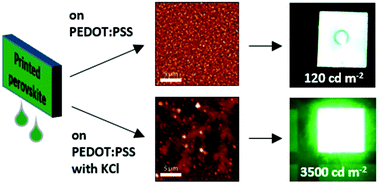(Printed perovskite LEDs – an innovative technique towards a new standard process of electronics manufacturing)
2020/6/12 ドイツ連邦共和国・ヘルマン・フォン・ヘルムホルツ協会(HGF)
・ HGF の HZB(物質・エネルギーヘルムホルツセンター)とベルリン・フンボルト大学の研究チームが、ハイブリッド(金属ハライド)ペロブスカイト半導体材料を使用したインクジェットプリンティングによるLEDs の作製に成功。様々な電子コンポーネント製造におけるペロブスカイト利用の可能性を拓く。
・ トランジスタやデータ記憶デバイス等のマイクロエレクトロニクスではシリコンが、一方で LEDs 等のオプトエレクトロニクスデバイスでは複合的な半導体の窒化ガリウムが使用される。このように、特定のアプリケーションに最も適した特性を備えた機能性材料が用いられている。
・ ハイブリッドペロブスカイトは、その半導体結晶の有機と無機の構成要素を特定の構造に配列することで、あらゆる種類のマイクロエレクトロニクスコンポーネントの製造に利用できる。また、ペロブスカイト結晶は比較的簡単に液体から作製できるため、基板上での層毎のコンポーネント構築が可能。
・ HZB では、近年、化合物半導体溶液による太陽電池のプリント作製に成功しているが、今回初めて同様のプリンティング技術によりペロブスカイトを使用した LEDs を作製。
・ ただし、同ペロブスカイトでは高い発光効率が期待できるが、例えば有機半導体でプリント作製したLEDs では光度があまり優れないように、溶液で作製した半導体層では十分な品質の確保が難しい。基板上で前駆体を急速・均一に結晶化させる、誘引剤や触媒の利用が必要となる。
・ これを種結晶の利用により解決。基板に自発的に付着し、後続するペロブスカイト層のためのテンプレートを形成する塩化カリウム結晶を正孔注入層材料に混合することで、プリンティングによる作製では得られなかった高い光度と飛躍的に優れた電気特性を達成。
・ 多用途のペロブスカイトとコスト効果的でシンプルなプリンティングによるコンポーネント製造プロセスが提供する優位性を踏まえ、研究室にて同技術を利用したあらゆる電子コンポーネントの作製を目標とする。
URL: https://www.helmholtz-berlin.de/pubbin/news_seite?nid=21460;sprache=en;seitenid=74699
<NEDO海外技術情報より>
(関連情報)
Materials Horisons 掲載論文(アブストラクトのみ:全文は有料)
Finally, inkjet-printed metal halide perovskite LEDs – utilizing seed crystal templating of salty
PEDOT:PSS
URL: https://pubs.rsc.org/en/content/articlelanding/2020/MH/D0MH00512F#!divAbstract
Abstract
Solution-processable metal halide perovskites are increasingly implemented in perovskite-based light-emitting diodes (PeLEDs). Especially green PeLEDs based on methylammonium lead bromide (MAPbBr3) composites exhibit impressive optoelectronic properties, while allowing processing by low-cost and upscalable printing methods. In this study, we have investigated the influence of potassium chloride (KCl) blended into the common hole injection material poly(3,4-ethylenedioxythiophene) polystyrene sulfonate (PEDOT:PSS) to boost PeLED device performance. The inclusion of KCl firstly results in a change in morphology of the PEDOT:PSS layer, which then acts as a template during deposition of the perovskite layer. A MAPbBr3:polyethylene glycol (PEG) composite was used, which does not require the deposition of an anti-solvent droplet to induce preferential perovskite crystallization and is therefore suitable for spin coating and scalable inkjet printing processes. PeLEDs utilizing the KCl induced templating effect on a planar PEDOT:PSS/MAPbBr3:PEG architecture show improved performance, predominantly due to improved crystallization. PeLEDs incorporating spin-coated perovskite layers yield a 40-fold increase in luminance (8000 cd m−2) while the turn-on voltage decreases to 2.5 V. KCl-modified PEDOT:PSS contact layers enabled the realization of inkjet-printed PeLEDs with luminance increased by a factor of 20 at a maximum of 4000 cd m−2 and a turn-on voltage of 2.5 V. This work paves the way for inkjet-printed perovskite light-emitting devices for a wide variety of low-cost and customizable applications.




